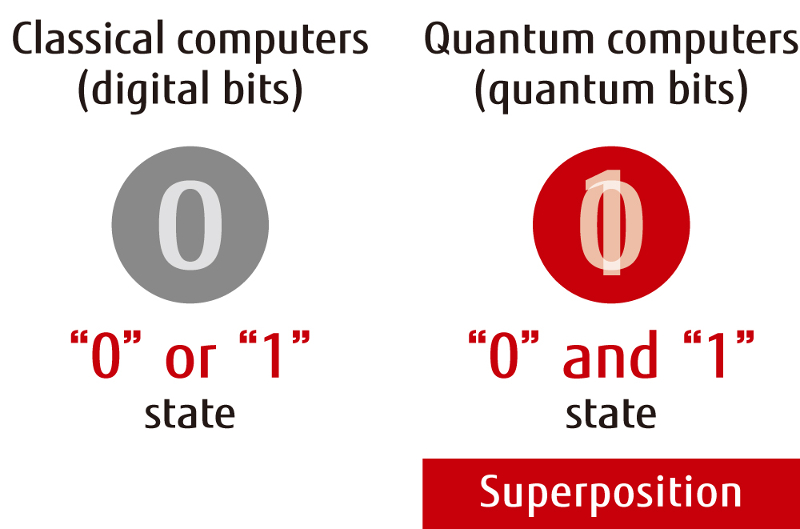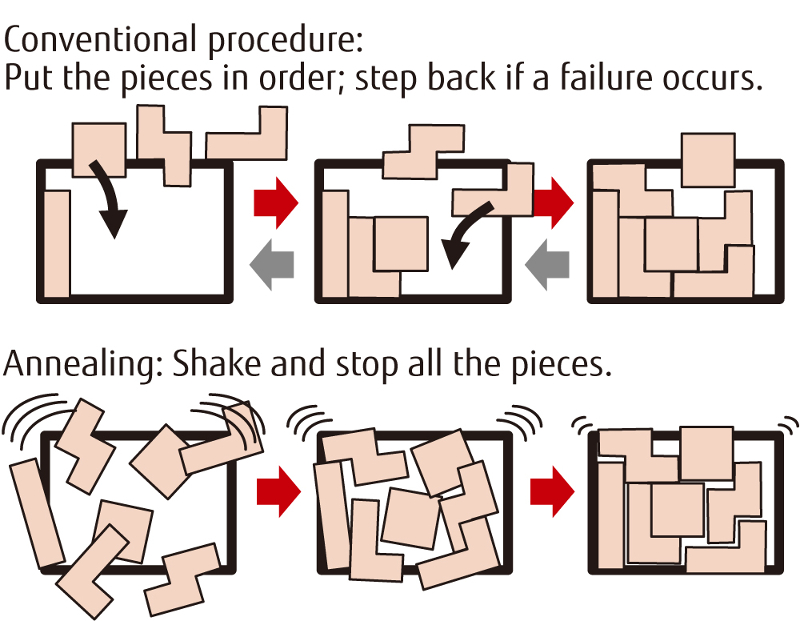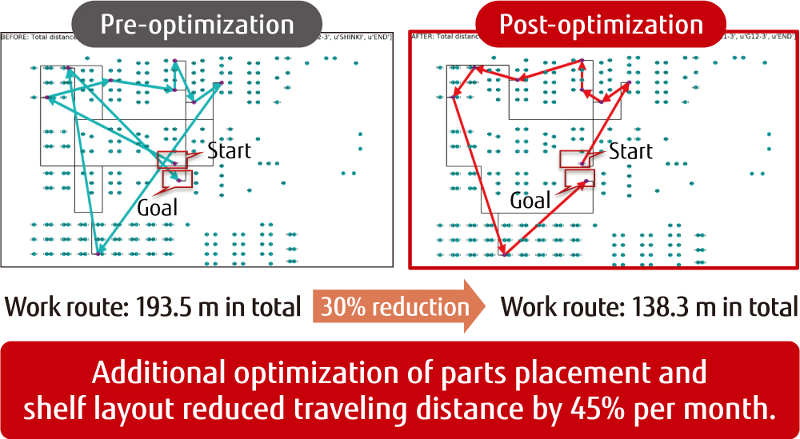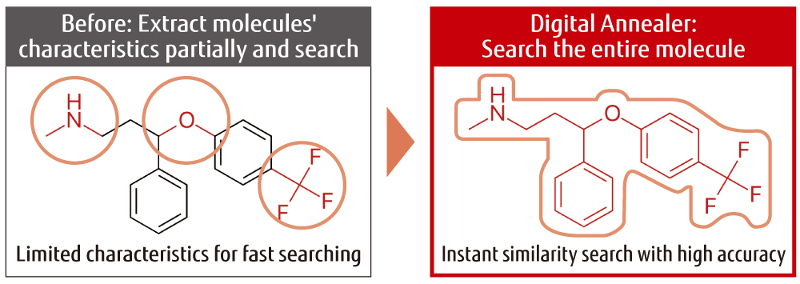Quantum computing in a Fujitsu Digital Annealer computer
From the 40s of the last century to the present, there were four main technologies on which computers were based: from electronic tubes to microprocessors. Since the advent of the first computers, the need for an ever increasing amount of computing resources has not stopped for a minute. Quantum computer computing is considered as one of the technologies of the next generation, which will realize the full potential of artificial intelligence (AI).
Fujitsu Digital Annealer was developed based on and subject to the limitations of quantum computing. In this article we will talk about what it represents for what it is intended.

Although quantum computing can process a huge amount of information in seconds, which modern computers cannot, they also have a number of limitations. While quantum computing is very expensive, it is difficult to put into practice and requires specific conditions to work. In other words, quantum computing significantly increases capital and operating expenses, not to mention the emerging need for employees with the appropriate qualifications to service quantum infrastructure.
For example, in order to achieve the correct output of quantum bits (by analogy with digital bits), they need to be in a superposition close to zero degrees, without any external interference. If at least one of these conditions is not met, the calculation results will be incorrect. Such stringent requirements for conditions make quantum computing difficult and inaccessible for many sectors of the economy.
Gigantic performance and a lot of computational time are required to take full advantage of AI. The need for faster computers dictates a high level of scaling of integrated circuits and integrated circuits with three-dimensional structures.
According to Moore's law, the density of transistors in integrated circuits will increase by 2 times every year and a half. Today, this process has reached its limit.
Quantum computing, which is based on fundamentally different laws, is considered as a key element that will allow us to abandon the limitations of Moore’s law and build new platforms for realizing the full potential of artificial intelligence. The development of AI will lead to the creation of new technologies and cause large-scale cultural shifts that will cause the emergence of “technological singularity”.
Quantum computers are based on quantum theory, which explains the phenomena that occur at the atomic and subatomic levels, including the behavior of electrons. In quantum mechanics, a phenomenon called “superposition” refers to the simultaneous appearance of two different states: 0 and 1. This phenomenon creates the basis for “quantum bits” that can significantly increase the speed of computational operations.

The difference between universal or classical and quantum computers
However, quantum computers are still in the making. And although their practical application is still quite far away, humanity now needs tools for analyzing big data and the ability to use AI to solve pressing problems.

Computers today and tomorrow
Fujitsu has developed a futuristic computer based on a new architecture that takes advantage of both quantum and classical computers. Among the various quantum computing methods currently on the market, Digital Annealer implements an annealing method that focuses on combinatorial optimization problems . The use of digital annealing technology does not require programming. The user simply sets the key parameters on the basis of which the calculations are performed.
When using the annealing method using original quantum devices, it is very difficult to maintain quantum states. In addition, such systems are large. Also, quantum bits can only be connected to closely spaced quantum bits due to the need for their physical contact.

List of quantum computing methods
Fujitsu used traditional semiconductor technology and developed the Digital Annealer computer based on a new architecture that can quickly solve the problem of combinatorial optimization without additional costs and difficulties associated with quantum computing.

Quantum annealing method for solving combinatorial optimization problems
Digital Annealer can handle more complex computational tasks compared to other quantum annealing systems, as Its fully connected structure allows devices to freely exchange signals within a single computer. Moreover, it can operate at normal temperature without the need for cooling to maintain the temperature at absolute zero (-273.15 ℃). In addition, it has a relatively small size for installation in the rack of the data center, unlike real quantum computers. Fujitsu now offers the Digital Annealer computer as a cloud service that any organization can access.
Problems of combinatorial optimization have existed for many years. They are almost impossible to solve with the help of classic computers, because the amount of computation grows exponentially, even when the number of elements in the optimal combination increases slightly.
1. Optimization of product placement in enterprises and warehouses
In real-world application scenarios, many problems can be solved using combinatorial optimization. For example, in enterprises and warehouses, a computer will allow you to quickly optimize work paths and product placement, minimizing the time it takes employees to find the right product name. The use of the Digital Annealer computer reduced the distance traveled by an employee by 45% per month within the same enterprise within the Fujitsu group of companies.

Optimized distribution of products in the enterprise
2. Personalized advertising in the framework of Internet marketing
The selection of advertisements and articles published on the Internet can be changed in accordance with the characteristics of the target audience (for example, age and gender), if they are known in advance. Providing performance data for each page allows visitors to display personalized information.
With 6 characteristics, a total of 720 ad combinations can be shown to a potential buyer. And with 20 characteristics, the number of combinations increases to 2.43 quintillion (1 * 1018). With Digital Annealer, these complex calculations can be done instantly.
There are many applications for the above technologies, including weather analysis and optimization of transportation methods.

Offering route paths optimized for a specific user
3. Low-risk diversified financial investments
Digital Annealer can be used to reduce risks by optimizing your investment portfolio. For example, a set of stocks of 20 or more companies creates a large number of combinations (more than 1 quintillion), which classical computers are not able to handle. Digital Annealer can instantly identify a less risky asset for investments, even if 500 companies are simultaneously in the investment portfolio.

Reducing investment risks by optimizing your investment portfolio
4. Quick search for molecular similarity in drug development
Chemical laboratories and pharmaceutical companies often use the “molecular similarity search” method to develop new drugs. If two molecules can be separated into atoms and the degree of coincidence can be determined, the search for similarity will demonstrate very high accuracy. Unfortunately, this technique requires a lot of time, even when using powerful computers.
Using the Digital Annealer computer, the search for the complete molecule structure can be done very quickly, accelerating the development of new drugs.

Search for molecular similarity in chemistry / pharmacy
Big data and AI analysis are playing an increasingly important role in creating innovations for business, so some companies have already begun investing in AI and data mining. However, the difficulties with optimizing business processes are that solving many problems requires too much computing resources. Now this can be solved with the help of quantum computing technologies.
In 2018, companies will begin the practical use of quantum computing technologies. And Fujitsu Digital Annealer will help them in this, making it easy and simple to test hypotheses that previously required too much time and computing resources.
Fujitsu Digital Annealer was developed based on and subject to the limitations of quantum computing. In this article we will talk about what it represents for what it is intended.

Although quantum computing can process a huge amount of information in seconds, which modern computers cannot, they also have a number of limitations. While quantum computing is very expensive, it is difficult to put into practice and requires specific conditions to work. In other words, quantum computing significantly increases capital and operating expenses, not to mention the emerging need for employees with the appropriate qualifications to service quantum infrastructure.
For example, in order to achieve the correct output of quantum bits (by analogy with digital bits), they need to be in a superposition close to zero degrees, without any external interference. If at least one of these conditions is not met, the calculation results will be incorrect. Such stringent requirements for conditions make quantum computing difficult and inaccessible for many sectors of the economy.
Limitations of classic computers discovered in the practical use of AI
Gigantic performance and a lot of computational time are required to take full advantage of AI. The need for faster computers dictates a high level of scaling of integrated circuits and integrated circuits with three-dimensional structures.
According to Moore's law, the density of transistors in integrated circuits will increase by 2 times every year and a half. Today, this process has reached its limit.
Quantum computing, which is based on fundamentally different laws, is considered as a key element that will allow us to abandon the limitations of Moore’s law and build new platforms for realizing the full potential of artificial intelligence. The development of AI will lead to the creation of new technologies and cause large-scale cultural shifts that will cause the emergence of “technological singularity”.
Quantum computers are based on quantum theory, which explains the phenomena that occur at the atomic and subatomic levels, including the behavior of electrons. In quantum mechanics, a phenomenon called “superposition” refers to the simultaneous appearance of two different states: 0 and 1. This phenomenon creates the basis for “quantum bits” that can significantly increase the speed of computational operations.

The difference between universal or classical and quantum computers
However, quantum computers are still in the making. And although their practical application is still quite far away, humanity now needs tools for analyzing big data and the ability to use AI to solve pressing problems.

Computers today and tomorrow
Digital Annealer Computer - Implementation of Quantum Computing Technology
Fujitsu has developed a futuristic computer based on a new architecture that takes advantage of both quantum and classical computers. Among the various quantum computing methods currently on the market, Digital Annealer implements an annealing method that focuses on combinatorial optimization problems . The use of digital annealing technology does not require programming. The user simply sets the key parameters on the basis of which the calculations are performed.
When using the annealing method using original quantum devices, it is very difficult to maintain quantum states. In addition, such systems are large. Also, quantum bits can only be connected to closely spaced quantum bits due to the need for their physical contact.

List of quantum computing methods
Fujitsu used traditional semiconductor technology and developed the Digital Annealer computer based on a new architecture that can quickly solve the problem of combinatorial optimization without additional costs and difficulties associated with quantum computing.

Quantum annealing method for solving combinatorial optimization problems
Digital Annealer can handle more complex computational tasks compared to other quantum annealing systems, as Its fully connected structure allows devices to freely exchange signals within a single computer. Moreover, it can operate at normal temperature without the need for cooling to maintain the temperature at absolute zero (-273.15 ℃). In addition, it has a relatively small size for installation in the rack of the data center, unlike real quantum computers. Fujitsu now offers the Digital Annealer computer as a cloud service that any organization can access.
Practical application in various fields
Problems of combinatorial optimization have existed for many years. They are almost impossible to solve with the help of classic computers, because the amount of computation grows exponentially, even when the number of elements in the optimal combination increases slightly.
1. Optimization of product placement in enterprises and warehouses
In real-world application scenarios, many problems can be solved using combinatorial optimization. For example, in enterprises and warehouses, a computer will allow you to quickly optimize work paths and product placement, minimizing the time it takes employees to find the right product name. The use of the Digital Annealer computer reduced the distance traveled by an employee by 45% per month within the same enterprise within the Fujitsu group of companies.

Optimized distribution of products in the enterprise
2. Personalized advertising in the framework of Internet marketing
The selection of advertisements and articles published on the Internet can be changed in accordance with the characteristics of the target audience (for example, age and gender), if they are known in advance. Providing performance data for each page allows visitors to display personalized information.
With 6 characteristics, a total of 720 ad combinations can be shown to a potential buyer. And with 20 characteristics, the number of combinations increases to 2.43 quintillion (1 * 1018). With Digital Annealer, these complex calculations can be done instantly.
There are many applications for the above technologies, including weather analysis and optimization of transportation methods.

Offering route paths optimized for a specific user
3. Low-risk diversified financial investments
Digital Annealer can be used to reduce risks by optimizing your investment portfolio. For example, a set of stocks of 20 or more companies creates a large number of combinations (more than 1 quintillion), which classical computers are not able to handle. Digital Annealer can instantly identify a less risky asset for investments, even if 500 companies are simultaneously in the investment portfolio.

Reducing investment risks by optimizing your investment portfolio
4. Quick search for molecular similarity in drug development
Chemical laboratories and pharmaceutical companies often use the “molecular similarity search” method to develop new drugs. If two molecules can be separated into atoms and the degree of coincidence can be determined, the search for similarity will demonstrate very high accuracy. Unfortunately, this technique requires a lot of time, even when using powerful computers.
Using the Digital Annealer computer, the search for the complete molecule structure can be done very quickly, accelerating the development of new drugs.

Search for molecular similarity in chemistry / pharmacy
Digital Annealer opens up new possibilities for the future
Big data and AI analysis are playing an increasingly important role in creating innovations for business, so some companies have already begun investing in AI and data mining. However, the difficulties with optimizing business processes are that solving many problems requires too much computing resources. Now this can be solved with the help of quantum computing technologies.
In 2018, companies will begin the practical use of quantum computing technologies. And Fujitsu Digital Annealer will help them in this, making it easy and simple to test hypotheses that previously required too much time and computing resources.
